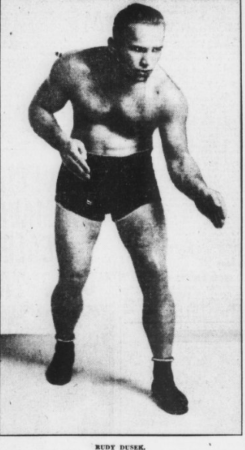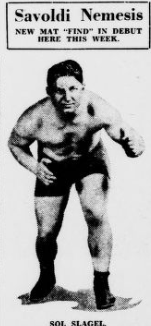Dusek Double-Crosses Mondt
Prior to the creation of the territorial system in 1948, pro wrestling promoters fought with each other to control the world championship. Promoting the world champion led to bigger gates, so most promoters wanted to control the championship.
In the 1930s, promoters would enter into agreements with each other but they were often fleeting. When one promoter got offended, thought he was being cheated or just didn’t like the other promoter, he would break the agreement.

Photo of Rudy Dusek, wrestler and promoter around 1919 (Public Domain)
In April 1933, Joseph “Toots” Mondt broke with his partners, when he double-crossed current World Champion Jim Londos. Mondt fixed the referee, Bobby Managoff, Sr., in Londos’ bout with “Jumping” Joe Savoldi. When Savoldi and Londos were tangled up, Managoff awarded a pinfall to Savoldi. The title change wasn’t recognized everywhere but Mondt was preparing to switch the title to Jim Browning anyway.
Browning, who had a disputed world title claim due to his defeat of Ed “Strangler” Lewis earlier in the year, defeated Savoldi in front of 6,000 rain drenched fans at Yankee Stadium on June 12, 1933. It was a disappointing crowd.
According to The Fall Guys: The Barnums of Bounce by Marcus Griffin, Rudy Dusek, wrestler and promoter, was furious at the double-crossing of Londos. Dusek was aligned with the Londos combine and wanted to embarrass Mondt.
Dusek enlisted the aid of a skilled Nebraska grappler Sol Slagel, who was scheduled to wrestled Savoldi at the Coast Guard base at Pier 18 on Staten Island.
Slagel embarrassed Savoldi by throwing him repeatedly. Savoldi was a football player without legitimate wrestling skills. Slagel grabbed Savoldi, stuffed any offense and kept dumping him to the mat.
Mondt had employed Captain Barry Peschmaylen to referee the bout. Seeing Savoldi’s predicament, Peschmaylen disqualified Slagel for rough tactics. The crowd knew no fouls occurred and began to riot. The Coast Guardmen saved the referee and Savoldi by escorting them from ringside.
Reporters wired the match results from the bout, which Jack Pfeffer said killed the house. Pfeffer said the open air match occurred in a driving rain. The house was so poor that neither Savoldi or Browning was paid for the match. As with many of the stories in The Fall Guys, the information is just a little off.

Photo of Sol Slagel -Courtesy of the Library of Congress
First, the results of the Savoldi-Slagel match had no effect on the Savoldi-Browning match. The championship match occurred on June 12, 1933. The double-cross occurred two weeks later on June 26, 1933. The terrible weather and controversy over the Londos-Savoldi bout most likely led to the terrible gate on June 12th.
Griffin’s version of the Savoldi versus Slagel match is pretty accurate with a few corrections. 4,000 fans filled the arena to watch the bout. Savoldi was a solid favorite going into the bout.
Slagel employed his legitimate wrestling skills to expose Savoldi’s lack of wrestling ability. For 22 minutes, Slagel tossed Savoldi around the ring. Savoldi was unable to generate any offense.
Capt. Boesch was managing Savoldi. Savoldi walked over to Boesch and was heard by ringsiders to say, “Stop the bout. He’ll throw me in a minute if you don’t.”
While Slagel threw Savoldi to the mat in a headlock, Capt. Boesch jumped up on the apron and spoke with the referee. The referee, who was surely in the pay of Mondt, signaled the fall was ended.
Fans initially thought Slagel had scored the first fall but the referee awarded the first fall to Savoldi on a foul. The fans knew no foul occurred and began booing loudly. No one attempted to riot.
Savoldi had left the ring and returned to his dressing room. The Coast Guard Officers, who organized the event, told Capt. Boesch that Savoldi would either return to the ring for the second fall or the match would be awarded to Slagel. Savoldi refused to return to the ring, so Slagel was actually awarded the match not Savoldi.
The result did embarrass both Mondt and Savoldi. It also further cast doubt on the Savoldi win over Londos. Like all double-crosses, it also exposed the worked nature of the wrestling business. It is amazing that the double-crosses in the 1930s did not damage wrestling more than they did.
I still recommend The Fall Guys as it is the only insider account that I know to cover this period of professional wrestling. Just remember that you may want to do further research on some of the information in the book.
You can leave a comment or ask a question about this or any post on my Facebook page.
Sources: The Fall Guys: The Barnums of Bounce by Marcus Griffin, The Pittsburgh Post-Gazette, June 13, 1933 edition, p. 15 and New York Daily News, June 27, 1933 edition, p. 448

